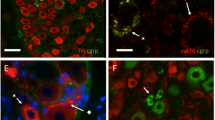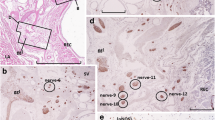Abstract
The pelvic ganglia are mixed ganglia containing both sympathetic and parasympathetic neurons that receive spinal input via the hypogastric (lumbar cord) and pelvic nerves (sacral cord), respectively. A recent study has utilised immunohistochemistry against synaptophysin (a protein associated with small vesicles) to visualise the preganglionic terminals in these ganglia. By selectively cutting the hypogastric or pelvic nerves and allowing subsequent terminal degeneration, the populations of parasympathetic and sympathetic preganglionic terminals, respectively, can be visualised. The present study has used this method in conjunction with retrograde labelling of pelvic neurons from the distal colon and double label immunofluorescence against tyrosine hydroxylase and vasoactive intestinal polypeptide (VIP) to identify and characterise the sympathetic and parasympathetic neurons projecting to the distal colon from the major pelvic ganglia of the male rat. Approximately equal numbers of distal colonic-projecting pelvic neurons are sympathetic and parasympathetic. Almost all noradrenergic neurons are sympathetic. Of the VIP neurons that project to the distal colon approximately one third are sympathetic, one third parasympathetic and the remaining third are possibly innervated by both the lumbar and sacral cord. Extrapolation from our results also suggests that the majority of non-noradrenergic neuropeptide Y neurons (which are known to comprise the remainder of the neurons) are parasympathetic. These studies have demonstrated that the pelvic ganglia are a major source of sympathetic innervation to the distal bowel and have further shown that the distal colon is another target for the non-noradrenergic sympathetic neurons of the pelvic ganglia.
Similar content being viewed by others
References
Christiansen J, Lorentzen M, Holst J (1990) Influence of peptides on anorectal function. Ann Med 22:413–418
Costa M, Furness JB (1973) The origins of the adrenergic fibres which innervate the internal anal sphincter, the rectum, and other tissues of the pelvic region in the guinea-pig. Z Anat Entwickl Gesch 140:129–142
Crowcroft PJ, Szurszewski JH (1971) A study of the inferior mesenteric and pelvic ganglia of guinea-pigs with intracellular electrodes. J Physiol 219:421–441
Dail WG (1993) Autonomic innervation of male reproductive genitalia. In: Maggi CA (ed) Nervous control of the urogenital system. Harwood Academic, Chur, Switzerland, pp 69–102
Dail WG, Dziurzynski R (1985) Substance P immunoreactivity in the major pelvic ganglion of the rat. Anat Rec 212:103–109
Dail WG, Evan AP, Eason HR (1975) The major ganglion in the pelvic plexus of the male rat. Cell Tissue Res 159:49–62
Dail WG, Manzanares K, Moll MA, Minorsky N (1985) The hypogastric nerve innervates a population of penile neurons in the pelvic plexus. Neuroscience 16:1041–1046
Dail WG, Minorsky N, Moll MA, Manzanares K (1986) The hypogastric nerve pathway to penile erectile tissue: histochemical evidence supporting a vasodilator role. J Auton Nerv Syst 15:341–349
Dail WG, Carrillo Y, Walton G (1990) Innervation of the anococcygeus muscle of the rat. Cell Tissue Res 259:139–146
Ekblad E, Winther C, Ekman R, Håkanson R, Sundler F (1987) Projections of peptide-containing neurons in rat small intestine. Neuroscience 20:169–188
Farrell JI, Lyman Y (1937) A study of the secretory nerves of, and the action of certain drugs on, the prostate gland. Am J Physiol 118:64–70
Furness JB, Costa M (1987) The enteric nervous system. Churchill Livingstone, Edinburgh
Furness JB, Costa M, Emson PC, Håkanson R, Moghimzadeh E, Sundler F, Taylor IL, Chance RE (1983) Distribution, pathways and reactions to drug treatment of nerves with neuropeptide Y and pancreatic polypeptide-like immunoreactivity in the guinea-pig digestive tract. Cell Tissue Res 234:71–92
Furness JB, Kuramoto H, Messenger JP (1990) Morphological and chemical identification of neurons that project from the colon to the inferior mesenteric ganglia in the guinea-pig. J Auton Nerv Syst 31:203–210
Grider JR, Makhlouf GM (1986) Colonic peristaltic reflex: Identification of vasoactive intestinal peptide as mediator of descending relaxation. Am J Physiol 251:G40-G45
Grider JR, Makhlouf GM (1990) Regulation of the peristaltic reflex by peptides of the myenteric plexus. Arch Int Pharmacodyn Ther 303:232–251
Hökfelt T, Elde R, Johanssen O, Luft R, Nilsson G, Arimura A (1976) Immunohistochemical evidence for separate populations of somatostatin-containing and substance P-containing primary afferent neurons in the rat. Neuroscience 1:131–136
Jänig W, McLachlan EM (1987) Organisation of lumbar spinal outflow to distal colon and pelvic organs. Physiol Rev 67:1332–1404
Jahn R, Schiebler W, Ouimet C, Greengard P (1985) A 38,000 dalton membrane protein (p38) present in synaptic vesicles. Proc Natl Acad Sci USA 82:4137–4141
Ju G, Hökfelt T, Brodin E, Fahrenkrug J, Fischer JA, Frey P, Elde RP, Brown JC (1987) Primary sensory neurons of the rat showing calcitonin gene-related peptide immunoreactivity and their relation to substance P-, somatostatin-, galanin-, vasoactive intestinal polypeptide- and cholecystokinin-immunoreactive ganglion cells. Cell Tissue Res 247:417–431
Keast JR (1987) Mucosal innervation and control of water and ion transport in the intestine. Rev Physiol Biochem Pharmacol 109:1–59
Keast JR (1991) Patterns of co-existence of peptides and differences of nerve fibre types associated with noradrenergic and non-noradrenergic (putative cholinergic) neurons in the major pelvic ganglion of the male rat. Cell Tissue Res 266:405–415
Keast JR (1994) Neuropeptide-containing axon terminals in the male rat major pelvic ganglion are primarily of sacral origin. J Auton Nerv Syst 47:151–158
Keast JR (1995) Visualisation and immunohistochemical characterization of sympathetic and parasympathetic neurons in the male rat major pelvic ganglion. Neuroscience (in press)
Keast JR, Chiam H-C (1994) Selective association of nerve fibres immunoreactive for substance P or bombesin with putative cholinergic neurons of the male rat major pelvic ganglion. Cell Tissue Res 278:589–594
Keast JR, Groat WC de (1989) Immunohistochemical characterisation of pelvic neurons which project to the bladder, colon, or penis in rats. J Comp Neurol 288:387–400
Keast JR, Booth AM, Groat WC de (1989) Distribution of neurons in the major pelvic ganglion of the rat which supply the bladder, colon or penis. Cell Tissue Res 256:105–112
King BF, Szurszewski JH (1989) Peripheral reflex pathways involving abdominal viscera transmission of impulses through prevertebral ganglia. Am J Physiol 256:G581-G588
Kuo DC, Hisamitsu T, Groat WC de (1984) A sympathetic projection from sacral paravertebral ganglia to the pelvic nerve and to postganglionic nerves on the surface of the urinary bladder and large intestine of the cat. J Comp Neurol 226:76–86
Langley JN, Anderson HK (1896) The innervation of pelvic and adjoining viscera. Part VII. Anatomical observations. J Physiol 20:372–406
Lee Y, Shiosaka S, Emson PC, Powell JF, Smith AD, Tohyama M (1985) Neuropeptide Y-like immunoreactive structures in the rat stomach with special reference to the noradrenaline neuron system. Gastroenterology 89:118–126
Luckensmeyer GB, Keast JR (1994) Projections from the prevertebral and major pelvic ganglia to the ileum and large intestine of the male rat. J Auton Nerv Syst 49:247–259
Luckensmeyer GB, Keast JR (1995) Distribution and morphological characterisation of viscerofugal projections from the large intestine to the inferior mesenteric and pelvic ganglia of the male rat. Neuroscience (in press)
Messenger JP, Furness JB (1990) Projections of chemically-specified neurons in the guinea-pig colon. Arch Histol Cytol 53:467–495
Minorsky NM, Dail WG (1993) The effect of chronic decentralisation on the enkephalin immunoreactive plexus around penile ganglionic neurons. J Auton Nerv Syst 45:215–223
Morris JL, Gibbins IL (1992) Co-transmission and neuromodulation. In: Burnstock G, Hoyle CHV (eds) Autonomic neuroeffector mechanisms. Harwood Academic, Chur, Switzerland, pp 31–117
Neuhuber WL, Appelt M, Polak JM, Baier-Kustermann W, Abelli L, Ferri G-L (1993) Rectospinal neurons: cell bodies, pathways, immunocytochemistry and ultrastructure. Neuroscience 56:367–378
Panula P, Hadjiconstantinou M, Yang H-YT, Costa E (1983) Immunohistochemical localisation of bombesin/gastrin-releasing peptide and substance P in primary sensory neurons. J Neurosci 3:2021–2029
Potter EK (1988) Neuropeptide Y as an autonomic neurotransmitter. Pharmac Ther 37:251–273
Purinton PT, Fletcher TF, Bradley WE (1973) Gross and light microscopic features of the pelvic plexus in the rat. Anat Rec 175:697–706
Schultzberg M, Dalsgaard C-J (1983) Enteric origin of bombesin immunoreactive fibres in the rat coeliac-superior mesenteric ganglion. Brain Res 269:190–195
Schultzberg M, Hökfelt T, Nilsson G, Terenius L, Rehfeld JF, Brown M, Elde R, Goldstein M, Said S (1980) Distribution of peptide- and catecholamine- containing neurons in the gastrointestinal tract of rat and guinea-pig: Immunohistochemical studies with antisera to substance P, vasoactive intestinal polypeptide, enkephalins, somatostatin, gastrin/cholecystokinin, neurotensin and dopamine-β-hydroxylase. Neuroscience 5: 689–744
Senba E, Yanaihara C, Yanaihara N, Tojyama M (1988) Co-localisation of substance P and Met-enkephalin-Arg6-Glu7-Leu8 in the intraspinal neurons of the rat, with special reference to the neurons in the substantia gelatinosa. Brain Res 453:110–116
Tabatabai M, Booth AM, Groat WC de (1986) Morphological and electrophysiological properties of pelvic ganglion cells in the rat. Brain Res 382:61–70
Traurig HH, Papka RE (1993) Autonomic efferent and visceral sensory innervation of the female reproductive system: special reference to the functional roles of nerves in reproductive organs. In: Maggi CA (ed) Nervous control of the urogenital system. Harwood Academic, Chur, Switzerland, pp 103–142
Wozniak W, Skowronska U (1967) Comparative anatomy of pelvic plexus in cat, dog, rabbit, macaque and man. Anat Anz 120:457–473
Yokota R, Burnstock G (1983) Decentralisation of neurones in the pelvic ganglion of the guinea-pig: Reinnervation by adrenergic nerves. Cell Tissue Res 232:399–411
Author information
Authors and Affiliations
Rights and permissions
About this article
Cite this article
Luckensmeyer, G.B., Keast, J.R. Immunohistochemical characterisation of sympathetic and parasympathetic pelvic neurons projecting to the distal colon in the male rat. Cell Tissue Res. 281, 551–559 (1995). https://doi.org/10.1007/BF00417873
Received:
Accepted:
Issue Date:
DOI: https://doi.org/10.1007/BF00417873




